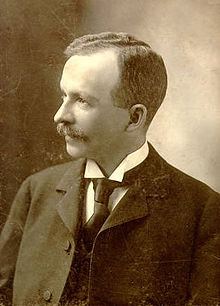Charles W. Chesnutt
Charles Waddell Chesnutt (born June 20, 1858 in Cleveland , Ohio , † November 15, 1932 ibid) was an American writer , poet , essayist and early representative of African American literature .
biography
Chesnutt was the grandson of a white slave owner who had a love affair with a slave that became Chesnutt's father. He did not start school until the age of eight, but six years later, in 1872, at the age of fourteen after the death of his mother, he took up a job as a teacher in order to be able to support his father's family. After teaching in Charlotte, North Carolina , he became principal of the Fayetteville State Normal School for Negroes in 1877 .
In 1884 he moved to Cleveland with his wife and three children, Ethel, Helen and Edwin, where he studied law and was admitted to the bar in 1887 ( Ohio State Bar ). He then took up a position as a lawyer .
In his Afro-American literature with its formative stories, essays and poems , he dealt in particular with “white” literature and prejudices. As a critical representative of local color fiction, he demythologized the sentimental glorification of the good ole times of the slave-holding period through the literary plantation tradition .
He was also involved in the civil rights movement alongside Booker T. Washington and was one of the first members of the National Association for the Advancement of Colored People (NAACP) founded on February 12, 1909 in 1910 . In 1928 he was awarded the NAACP Spingarn Medal for his life's work .
Works
Chestnutt made his literary debut in 1885 with the short story Uncle Peter's House , in the daily newspaper Cleveland News and Herald was published. Two years later, in his early short story, The Goophered Grapevine (1887) , he portrayed the Scuppernong , the state fruit of North Carolina .
After collecting short stories entitled The Conjure Woman (1899) and The Wife of His Youth and Other Stories of the Color Line (1899), he published the novels The House Behind the Cedars (1900), The Marrow of Tradition (1901) and The Colonel's Dream (1905).
In The Marrow of Tradition he described the so-called race riots in Wilmington (North Carolina) of 1898/99, for which he had collected material on a trip to the area, closely following real historical events . The background to this was a coup by local officials of the Democratic Party against the Republican Party , which had dominated the elections in 1894 and 1896 and in which many African-Americans had organized themselves. The whites who gathered in secret organizations refused to obey instructions from black police officers or judges; they were supported by the democratic press in inflammatory articles against the (numerically clearly given) negro dominance . In 1899 the black Sam Hose was neutered and burned alive. Chestnutt relates the hysteria of the white male population of Wilmington to their threatened economic and political loss of power; they stylize themselves as knights who protect the white women from wild hordes.
Web links and sources
- Charles W. Chesnutt in nndb (English)
- The Charles Chesnutt Digital Archive
- Homepage (charleschesnutt.org)
- Biography (online-literature.com)
- Biography and works (aalbc.com)
- Charles W. Chesnutt (1858-1932)
Individual evidence
- ^ Amy Kaplan: Nation, Region, and Empire , in: Columbia History of the American Novel, New York: Columbia University Press, 1991, p. 244.
- ↑ The Marrow of Tradition (Google Books)
- ↑ Eric J. Sunquist: Introduction . In: Charles W. Chesnutt: The Marrow of Tradition. New York et al. a. (Penguin) 1993.
| personal data | |
|---|---|
| SURNAME | Chesnutt, Charles W. |
| ALTERNATIVE NAMES | Chesnutt, Charles Waddell (full name) |
| BRIEF DESCRIPTION | American writer, lawyer, and civil rights activist |
| DATE OF BIRTH | June 20, 1858 |
| PLACE OF BIRTH | Cleveland , Ohio |
| DATE OF DEATH | November 15, 1932 |
| Place of death | Cleveland , Ohio |
